Integrated Metabolomic and Transcriptomic Analyses of Anthocyanin Synthesis During Fruit Development in Lycium ruthenicum Murr.
Simple Summary
Abstract
1. Introduction
2. Materials and Methods
2.1. Plant Material
2.2. Anthocyanin Content Measurement
2.3. Detection of the Metabolome
2.4. Identification and Quantitative Analysis of Metabolites
2.5. RNA Extraction and Sequencing
2.6. RNA-Seq Data Analysis and Annotation
2.7. Integrated Analysis of Metabolome and Transcriptome
2.8. Transcription Factor Analysis
2.9. Analysis of Gene Expression Using Quantitative Real Time-PCR (qRT-PCR)
2.10. Statistical Analysis
3. Results
3.1. Anthocyanin Levels During L. ruthenicum Fruit Development
3.2. Metabolite Analysis
3.3. Analysis of the Differentially Accumulated Metabolites (DAMs) in L. ruthenicum Fruits at the Five Developmental Stages
3.4. Identification of DEGs in L. ruthenicum Fruit
3.5. GO Analysis of DEGs
3.6. KEGG Analysis of DEGs
3.7. Integrated Analysis of the Metabolome and Transcriptome
3.8. Analysis of Pathways Related to Anthocyanin Biosynthesis
3.9. TFs Related to Anthocyanin Biosynthesis
3.10. qRT-PCR Analysis of Gene Expression
4. Discussion
5. Conclusions
Supplementary Materials
Author Contributions
Funding
Institutional Review Board Statement
Informed Consent Statement
Data Availability Statement
Conflicts of Interest
References
- Hoballah, M.E.; Gübitz, T.; Stuurman, J. Single Gene-mediated Shift in Pollinator Attraction in Petunia. Plant Cell. 2007, 19, 779–790. [Google Scholar] [CrossRef]
- Nevo, O.; Valenta, K.; Razafimandimby, D.; Melin, A.D.; Ayasse, M.; Chapman, C.A. Frugivsores and the Evsolution of Fruit Colour. Biol. Lett. 2018, 14, 20180377. [Google Scholar] [CrossRef]
- Landi, M.; Tattini, M.; Gould, K.S. Multiple Functional Roles of Anthocyanins in Plant-envsironment Interactions. Environ. Exp. Bot. 2015, 119, 4–17. [Google Scholar] [CrossRef]
- Schaefer, H.M.; Rentzsch, M.; Breuer, M. Anthocyanins Reduce Fungal Growth in fruit. Nat. Prod. Commun. 2008, 3, 1267–1272. [Google Scholar] [CrossRef]
- Alvsarez-Suarez, J.M.; Giampieri, F.; Tulipani, S. One-month Strawberry-rich Anthocyanin Supplementation Ameliorates Cardiovsascular Risk, Oxidativse Stress Markers and Platelet Activsation in Humans. J. Nutr. Biochem. 2014, 25, 289–294. [Google Scholar] [CrossRef]
- Carocho, M.; Barreiro, M.F.; Morales, P. Adding Molecules to Food, Pros and Cons: A Review on Synthetic and Natural Food Additives. Compr. Rev. Food Sci. Food Saf. 2014, 13, 377–399. [Google Scholar] [CrossRef]
- Tanaka, Y.; Sasaki, N.; Ohmiya, A. Biosynthesis of Plant Pigments: Anthocyanins, Betalains and Carotenoids. Plant J. 2008, 54, 733–749. [Google Scholar] [CrossRef]
- Tang, P.; Giusti, M.M. Black Goji as a Potential Source of Natural Color in a Wide PH Range. Food Chem. 2018, 269, 419–426. [Google Scholar] [CrossRef]
- Duan, Y.; Chen, F.; Yao, X. Protective Effect of L. ruthenicum Murr. Against Radiation Injury in Mice. Int. J. Environ. Res. Public Health 2015, 12, 8332–8347. [Google Scholar] [CrossRef]
- Chen, S.; Wang, H.; Hu, N. Long-Term Dietary Lycium ruthenicum Murr. Anthocyanins Intake Allevsiated Oxidativse Stress-Mediated Aging-Related Livser Injury and Abnormal Amino Acid Metabolism. Foods 2022, 11, 3377. [Google Scholar] [CrossRef]
- Ren, L.; Tan, N.; Ouyang, J. Hypoglycaemic Activity of the Anthocyanin Enriched Fraction of Lycium ruthenicum Murr. Fruits and its Ingredient Identification via UPLC-triple-TOF-MS/MS. Food Chem. 2024, 461, 140837. [Google Scholar] [CrossRef]
- Tian, B.; Zhao, J.; Xie, X. Anthocyanins from the fruits of Lycium ruthenicum Murray improve high-fat diet-induced insulin resistance by ameliorating inflammation and oxidative stress in mice. Food Funct. 2021, 12, 3855–3871. [Google Scholar] [CrossRef]
- Luo, Y.; Fang, J.L.; Yuan, K. Ameliorative Effect of Purified Anthocyanin From Lycium ruthenicum on Atherosclerosis in Rats Through Synergistic Modulation of the Gut Microbiota and NF-κB/SREBP-2 Pathways. J. Funct. Foods. 2019, 59, 223–233. [Google Scholar] [CrossRef]
- Kaur, A.; Sharma, K.; Pawar, S.V. Genome-wide characterization of PAL, C4H, and 4CL genes regulating the phenylpropanoid pathway in Vanilla planifolia. Sci. Rep. 2025, 15, 10714. [Google Scholar] [CrossRef]
- Yan, H.; Pei, X.; Zhang, H. MYB-Mediated Regulation of Anthocyanin Biosynthesis. Int. J. Mol. Sci. 2021, 22, 3103. [Google Scholar] [CrossRef] [PubMed]
- Li, M.; Cao, Y.T.; Ye, S.R. Isolation of CHS Gene from Brunfelsia Acuminata Flowers and Its Regulation in Anthocyanin Biosysthesis. Molecules 2016, 22, 44. [Google Scholar] [CrossRef] [PubMed]
- Zeng, S.; Wu, M.; Zou, C. Comparative Analysis of Anthocyanin Biosynthesis During Fruit Development in Two Lycium Species. Physiol. Plant. 2014, 150, 505–516. [Google Scholar] [CrossRef] [PubMed]
- Marin-Recinos, M.F.; Pucker, B. Genetic Factors Explaining Anthocyanin Pigmentation Differences. BMC Plant Biol. 2024, 24, 627. [Google Scholar] [CrossRef]
- Cao, Y.; Xu, L.; Xu, H. LhGST is an Anthocyanin-related Glutathione S-transferase Gene in Asiatic Hybrid Lilies (Lilium spp.). Plant Cell Rep. 2021, 40, 85–95. [Google Scholar] [CrossRef]
- Li, T.; Wang, J.; Zhang, Z. Anthocyanin Biosynthesis in Goji Berry is Inactivated by Deletion in a bHLH Transcription Factor LrLAN1b Promoter. Plant Physiol. 2024, 195, 1461–1474. [Google Scholar] [CrossRef]
- Zhao, M.; Li, J.; Zhu, L. Identification and Characterization of MYB-bHLH-WD40 Regulatory Complex Members Controlling Anthocyanidin Biosynthesis in Blueberry fruit Development. Genes 2019, 10, 496. [Google Scholar] [CrossRef]
- Li, M.; Yang, Y.; Wang, H. The Mutations in RcMYB114 Affect Anthocyanin Glycoside Accumulation in Rose. Biology 2025, 14, 258. [Google Scholar] [CrossRef]
- Ma, X.; Liang, G.; Xu, Z. CaMYBA-CaMYC-CaTTG1 Complex Activates the Transcription of Anthocyanin Synthesis Structural Genes and Regulates Anthocyanin Accumulation in Pepper (Capsicum annuum L.) leaves. Front. Plant Sci. 2025, 16, 1538607. [Google Scholar] [CrossRef]
- Liu, J.; Yang, Y.; Xiang, Y. Melatonin promotes anthocyanin biosynthesis in postharvest litchi fruit via regulation of the transcription factor LcWRKY17. Postharvest Biol. Technol. 2026, 231, 113885. [Google Scholar] [CrossRef]
- Yu, S.; Zhang, J.; Cao, Y. Combined Transcriptome and Metabolome Analysis Reveals That DcWRKY11 Promotes Methyl Jasmonate-Induced Proanthocyanidin Biosynthesis in Dioscorea composita. Plant Cell Environ. 2025, 48, 6782–6795. [Google Scholar] [CrossRef]
- Jin, Z.; Wang, W.; Nan, Q. VvNAC17, a grape NAC transcription factor, regulates plant response to drought-tolerance and anthocyanin synthesis. Plant Physiol. Biochem. 2025, 219, 109379. [Google Scholar] [CrossRef] [PubMed]
- Liang, L.; Zhu, J.; Yang, W. A Repression-Activation System Involving miR164a-NACs Regulates Tissue-Specific Anthocyanin Accumulation in Peach Fruit. Plant Biotechnol. J. 2025, 23, 5279–5296. [Google Scholar] [CrossRef] [PubMed]
- Li, R.; Xia, S.; Long, Q. Functional analysis of AP2/ERF family members in flavonoid biosynthesis of wolfberry. Front. Plant Sci. 2025, 16, 1632482. [Google Scholar] [CrossRef]
- Zeng, M.; Wu, Y.; Lin, S. Disruption of ABI4 Enhances Anthocyanin Accumulation in Arabidopsis Seedlings Through HY5-Mediated Light Signaling. Plants 2025, 14, 1905. [Google Scholar] [CrossRef] [PubMed]
- Meng, Y.; Bai, Y.; Chen, D. Integration of transcriptome and metabolome reveals key regulatory mechanisms affecting sepal color variation in Aquilegia oxysepala. Sci. Hortic. 2024, 334, 113334. [Google Scholar] [CrossRef]
- Liu, C.; Yu, H.; Liu, Y.; Zhang, L.; Li, D.; Zhao, X.; Zhang, J.; Sui, Y. Promoting Anthocyanin Biosynthesis in Purple Lettuce through Sucrose Supplementation under Nitrogen Limitation. Horticulturae 2024, 10, 838. [Google Scholar] [CrossRef]
- Li, G.; Zhao, J.; Qin, B. ABA Mediates Development-dependent Anthocyanin Biosynthesis and Fruit Coloration in Lycium Plants. BMC Plant Biol. 2019, 19, 317. [Google Scholar] [CrossRef]
- Li, T.; Fan, Y.; Qin, H. Transcriptome and Flavonoids Metabolomic Analysis Identifies Regulatory Networks and Hub Genes in Black and White fruit of Lycium ruthenicum Murray. Front. Plant Sci. 2020, 11, 1256. [Google Scholar] [CrossRef] [PubMed]
- Xu, Y.; Li, H.; Shi, T. High-quality Genome of Black Wolfberry (Lycium ruthenicum Murr.) Provides Insights into the Genetics of Anthocyanin Biosynthesis Regulation. Hortic. Res. 2024, 12, uhae298. [Google Scholar] [CrossRef]
- Ai, P.; Wei, G.; Biao, A.; Yang, C.; Wang, Y.; Zeng, S. Multi-omics Reveal the Molecular Basis of LrAN2 Overexpression in Black Goji Callus Promoting the Excessive Accumulation of Petanin, a Promising Food Blue Colorant. Food Front. 2024, 5, 2221–2234. [Google Scholar] [CrossRef]
- Kanehisa, M.; Araki, M.; Goto, S. KEGG for linking genomes to life and the environment. Nucleic Acids Res. 2008, 36, D480–D484. [Google Scholar] [CrossRef]
- Zheng, Y.; Jiao, C.; Sun, H. ITAK: A Program for Genome-wide Prediction and Classification of Plant Transcription Factors, Transcriptional Regulators, and Protein Kinases. Mol. Plant. 2016, 9, 1667–1670. [Google Scholar] [CrossRef]
- Wang, W.D. Extraction and Biological Activity Study of Alkaloids in Tobacco. Ph.D. Thesis, Huazhong Agricultural University, Wuhan, China, 2018. [Google Scholar]
- Hua, Q.Z. Screening and Identification of Key Genes in the Biosynthesis of Betalains in Pitaya. Ph.D. Thesis, South China Agricultural University, Guangzhou, China, 2020. [Google Scholar] [CrossRef]
- Katamreddy, S.; Jose, J.; Reddy, B. Drought-Induced Cyanogenesis in Sorghum (Sorghum bicolor L.): Genotypic Variation in Dhurrin Biosynthesis and Stress Response. Plant Cell Environ. 2025. Early view. [Google Scholar] [CrossRef]
- Duan, L.; Zhang, B.; Dai, G. Integrated Analysis of Transcriptome and Metabolome Reveals New Insights into the Molecular Mechanism Underlying the Color Differences in Wolfberry (Lycium barbarum). Agronomy 2023, 13, 1926. [Google Scholar] [CrossRef]
- Chen, S.R.; Shi, M.W.; Ye, G.J. Research on the Anthocyanin Components and Their Relative Contents in Various Tissues of Black Goji Berry (Lycium ruthenicum). Food Ferment. Ind. 2023, 49, 201–207. [Google Scholar] [CrossRef]
- Wang, C.; Dong, Y.; Zhu, L. Comparative Transcriptome Analysis of Two Contrasting Wolfberry Genotypes During Fruit Development and Ripening and Characterization of the LrMYB1 Transcription Factor that Regulates Flavonoid Biosynthesis. BMC Genom. 2020, 21, 295. [Google Scholar] [CrossRef]
- Xie, Z.; Luo, Y.; Zhang, C. Integrated Metabolome and Transcriptome during Fruit Development Reveal Metabolic Differences and Molecular Basis between Lycium barbarum and Lycium ruthenicum. Metabolites 2023, 13, 680. [Google Scholar] [CrossRef]
- Ma, S.; Zhou, H.; Ren, T. Integrated Transcriptome and Metabolome Analysis Revealed that HaMYB1 Modulates Anthocyanin Accumulation to Deepen Sunflower Flower Color. Plant Cell Rep. 2024, 43, 74. [Google Scholar] [CrossRef] [PubMed]
- Ayako, K.; Zion, B.; Suzuka, O. Characterization of the Recombinant UDP:Flavonoid 3-O-Galactosyltransferase from Mangifera Indica ‘Irwin’ (MiUFGalT3) Involved in Skin Coloring. Hortic. J. 2020, 89, 516–524. [Google Scholar] [CrossRef]
- Li, Z.; Wang, J.; Gao, Y. The AnUFGT1 Is Involved in the Anthurium ‘Alabama’ Anthocyanidin Deficiency. Horticulturae 2024, 10, 369. [Google Scholar] [CrossRef]
- Eichenberger, M.; Schwander, T.; Hüppi, S. The Catalytic Role of Glutathione Transferases in Heterologous Anthocyanin Biosynthesis. Nat. Catal. 2023, 6, 927–938. [Google Scholar] [CrossRef]
- Tasaki, K.; Yoshida, M.; Nakajima, M. Molecular Characterization of an Anthocyanin-related Glutathione S-transferase Gene in Japanese Gentian with the CRISPR/Cas9 System. BMC Plant Biol. 2020, 20, 370. [Google Scholar] [CrossRef] [PubMed]
- Li, Y.K.; Ma, X.Q.; Feng, J.X. Advances in the Study of Cytochrome P450 Enzymes in the Biosynthesis of Plant Secondary Metabolites. Mol. Plant Breed. 2024, 22, 2176–2183. [Google Scholar] [CrossRef]
- Yuan, S.; Qi, H.; Yang, S. Role of Delphinidin-3-glucoside in the Sepal Blue Color Change Among Hydrangea Macrophylla Cultivars. Sci. Hortic. 2023, 313, 111902. [Google Scholar] [CrossRef]
- Zhao, Y.; Sun, J.; Cherono, S. Colorful Hues: Insight into the Mechanisms of Anthocyanin Pigmentation in Fruit. Plant Physiol. 2023, 192, 1718–1732. [Google Scholar] [CrossRef]
- Wu, Y.; Wen, J.; Xia, Y. Evolution and Functional Diversification of R2R3-MYB Transcription Factors in Plants. Hortic. Res. 2022, 9, uhac058. [Google Scholar] [CrossRef]
- Du, H.; Zhai, Z.; Pu, J. Two Tandem R2R3 MYB Transcription Factor Genes Cooperatively Regulate Anthocyanin Accumulation in Potato Tuber Flesh. Plant Biotechnol. J. 2025, 23, 1521–1534. [Google Scholar] [CrossRef] [PubMed]
- Zong, Y.; Zhu, X.; Liu, Z. Functional MYB Transcription Factor Encoding Gene AN2 is Associated with Anthocyanin Biosynthesis in Lycium ruthenicum Murray. BMC Plant Biol. 2019, 19, 169. [Google Scholar] [CrossRef] [PubMed]
- Wu, S.; Hu, C.; Zhu, C. The MYC2-PUB22-JAZ4 Module Plays a Crucial Role in Jasmonate Signaling in Tomato. Mol. Plant. 2024, 17, 598–613. [Google Scholar] [CrossRef] [PubMed]

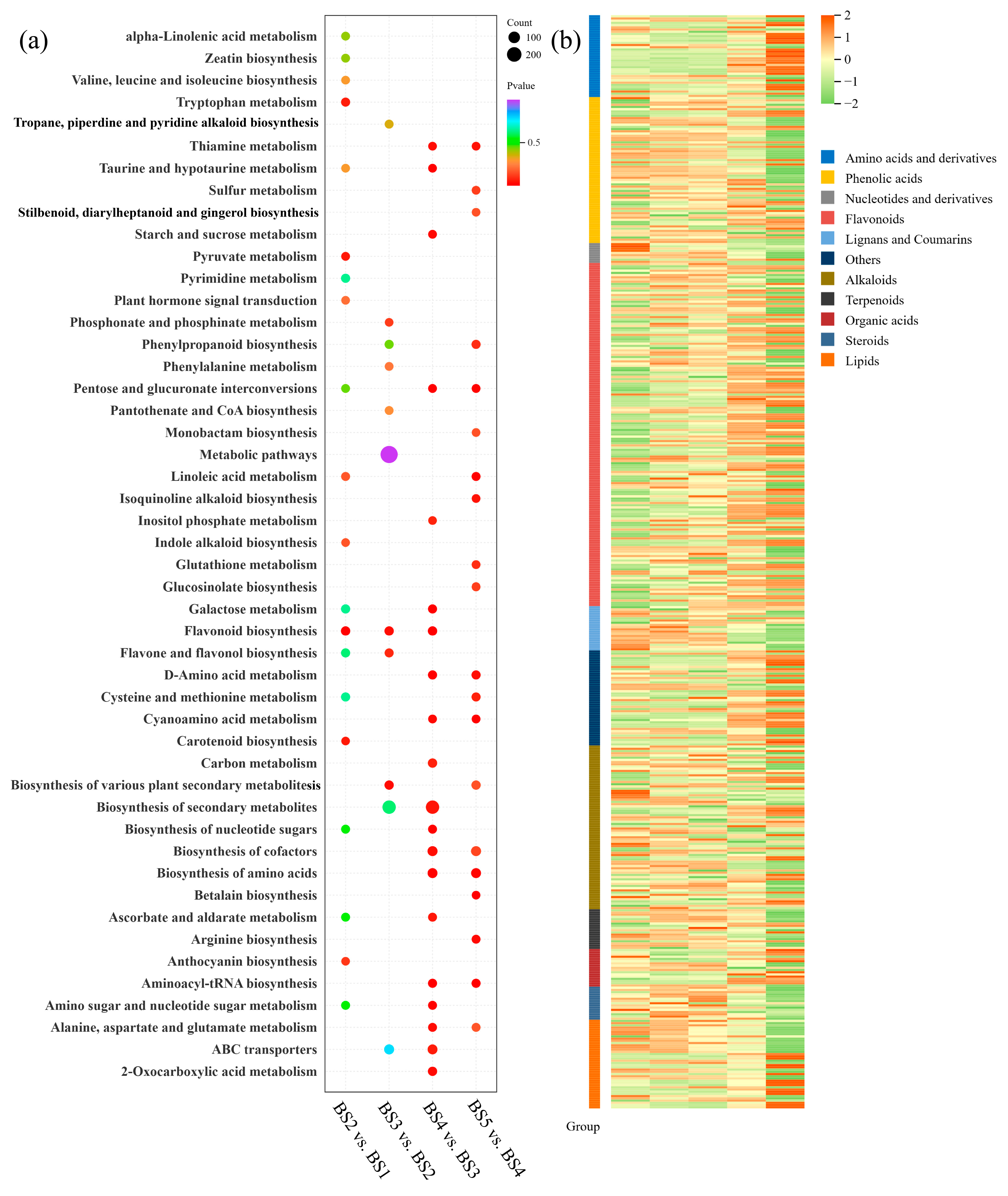
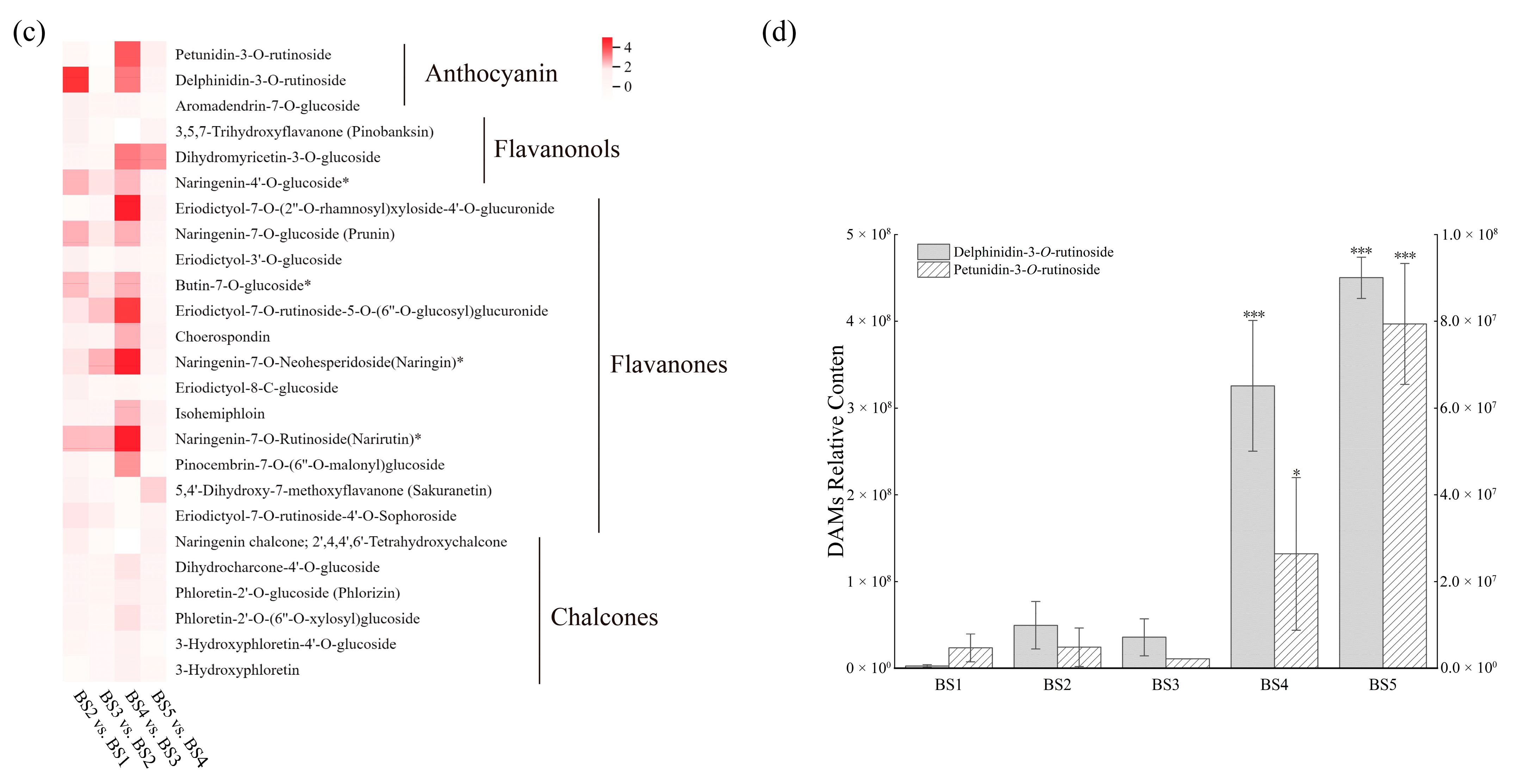
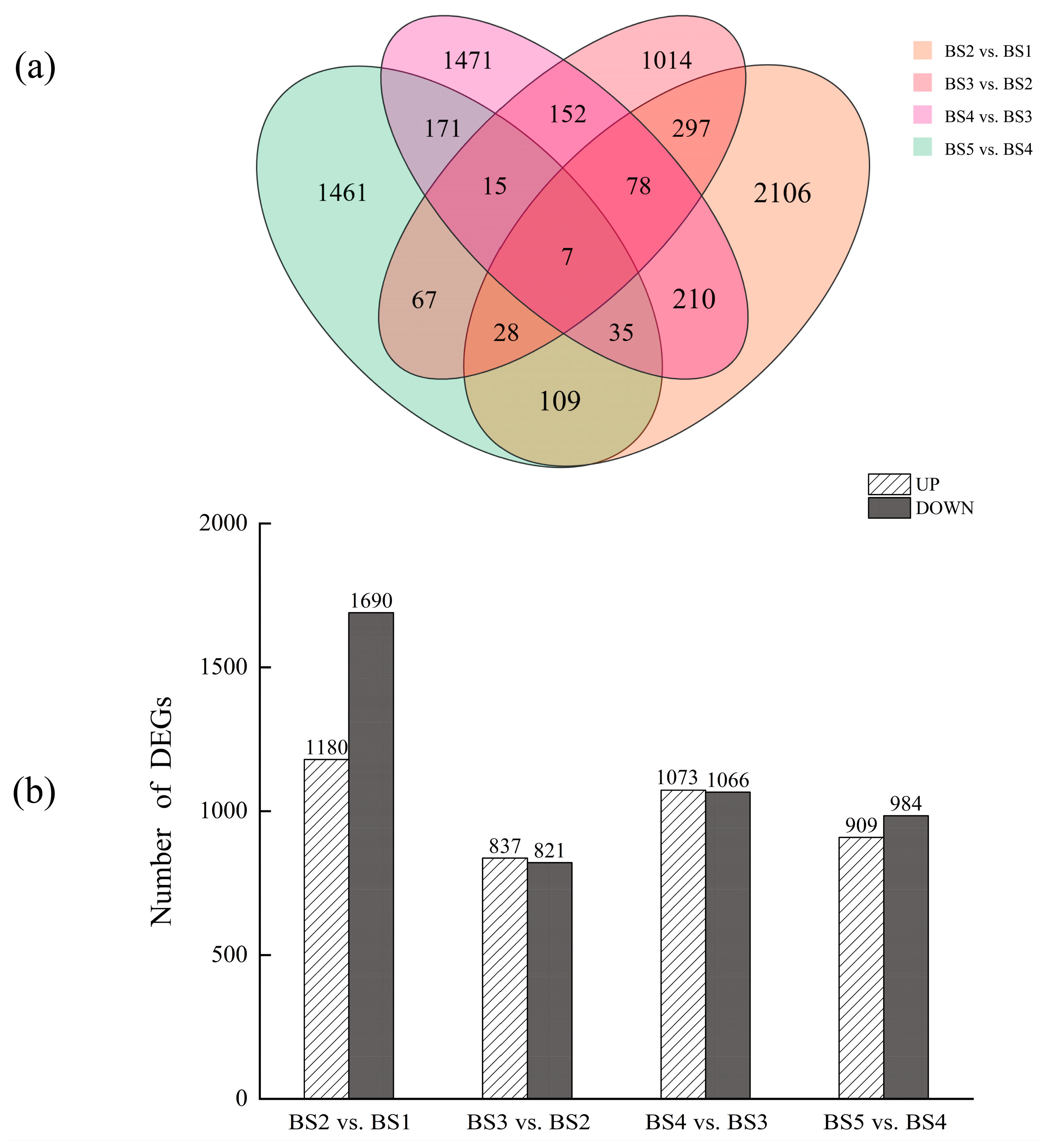
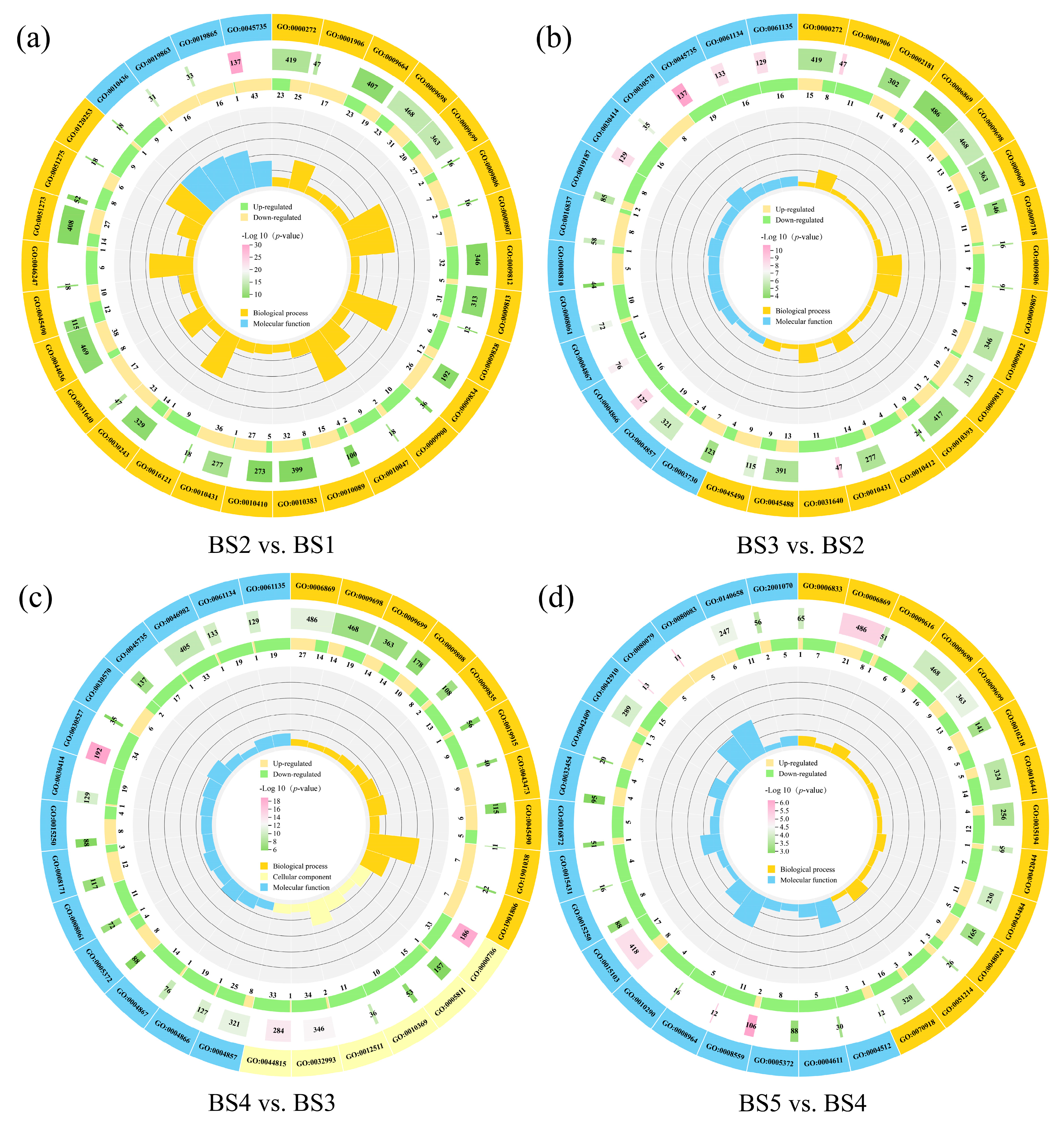
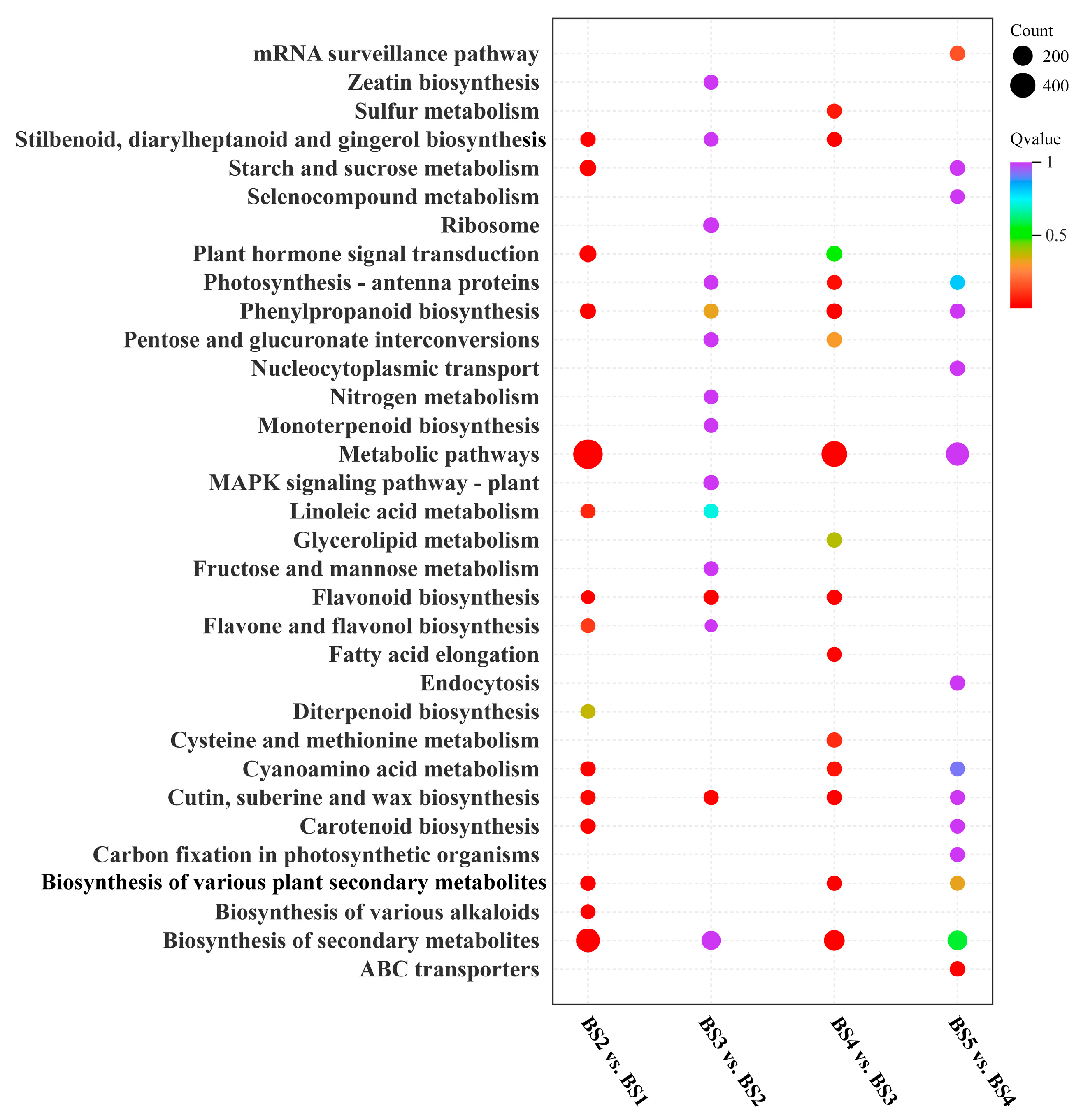


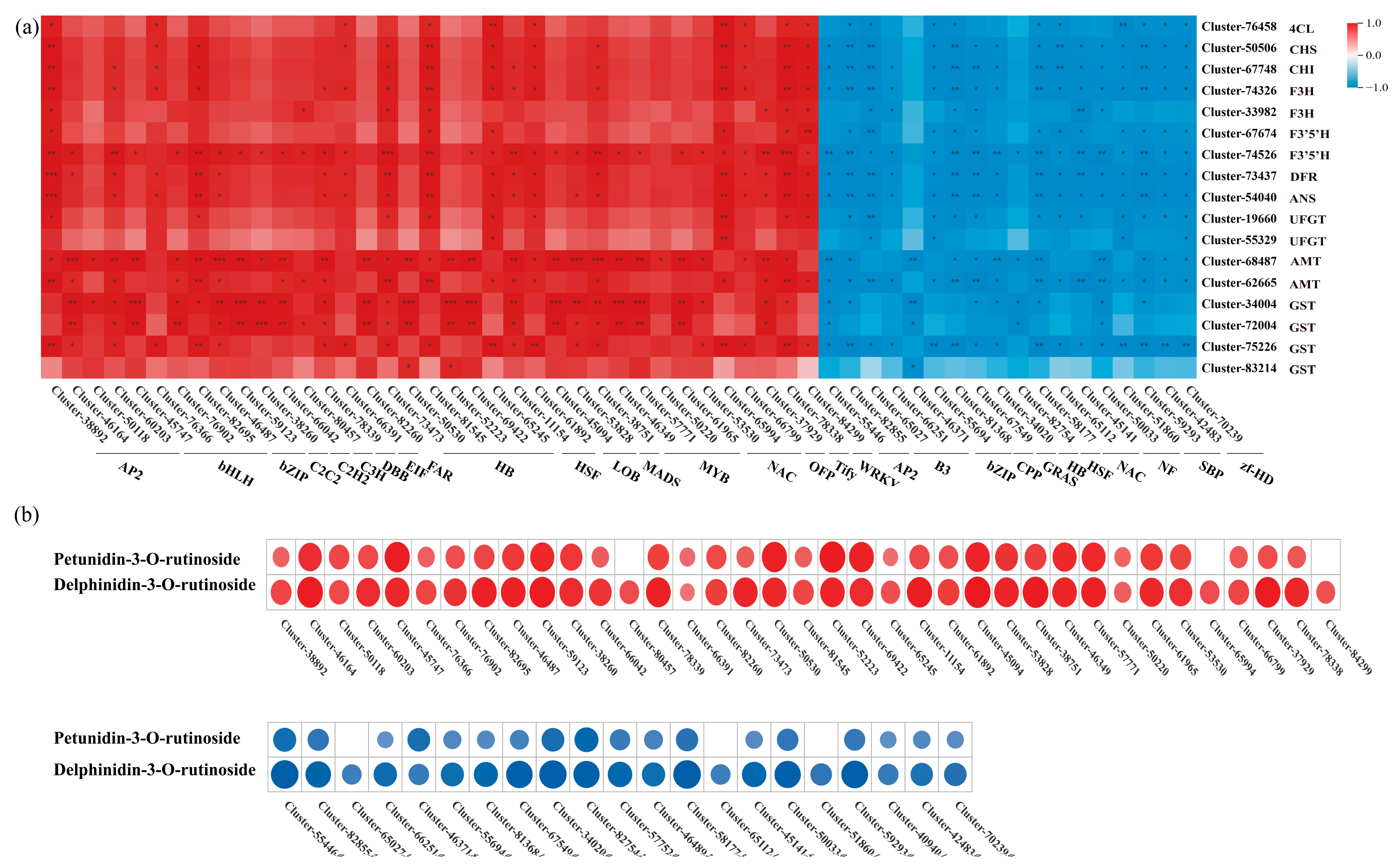
Disclaimer/Publisher’s Note: The statements, opinions and data contained in all publications are solely those of the individual author(s) and contributor(s) and not of MDPI and/or the editor(s). MDPI and/or the editor(s) disclaim responsibility for any injury to people or property resulting from any ideas, methods, instructions or products referred to in the content. |
© 2025 by the authors. Licensee MDPI, Basel, Switzerland. This article is an open access article distributed under the terms and conditions of the Creative Commons Attribution (CC BY) license (https://creativecommons.org/licenses/by/4.0/).
Share and Cite
Guo, J.; Wang, J.; Peng, C.; Liu, H.; Shang, J. Integrated Metabolomic and Transcriptomic Analyses of Anthocyanin Synthesis During Fruit Development in Lycium ruthenicum Murr. Biology 2025, 14, 1614. https://doi.org/10.3390/biology14111614
Guo J, Wang J, Peng C, Liu H, Shang J. Integrated Metabolomic and Transcriptomic Analyses of Anthocyanin Synthesis During Fruit Development in Lycium ruthenicum Murr. Biology. 2025; 14(11):1614. https://doi.org/10.3390/biology14111614
Chicago/Turabian StyleGuo, Jin, Jing Wang, Chunxiang Peng, Hui Liu, and Jie Shang. 2025. "Integrated Metabolomic and Transcriptomic Analyses of Anthocyanin Synthesis During Fruit Development in Lycium ruthenicum Murr." Biology 14, no. 11: 1614. https://doi.org/10.3390/biology14111614
APA StyleGuo, J., Wang, J., Peng, C., Liu, H., & Shang, J. (2025). Integrated Metabolomic and Transcriptomic Analyses of Anthocyanin Synthesis During Fruit Development in Lycium ruthenicum Murr. Biology, 14(11), 1614. https://doi.org/10.3390/biology14111614





